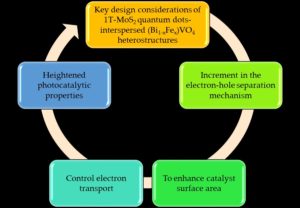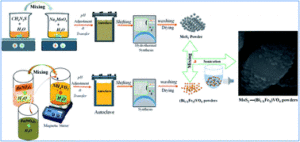We are very pleased to introduce Muhammad Munir Sajid, one of the corresponding authors of the paper ‘Construction of 1T-MoS2 quantum dots-interspersed (Bi1−xFex)VO4 heterostructures for electron transport and photocatalytic properties‘, and his co-authors. Their article has been very well received and handpicked by our reviewers and handling editors as one of our HOT articles. Munir told us more about the work that went into this article and what they hopes to achieve in the future. You can find out more about the authors and their article below and find more HOT articles in our online collection.
Meet the authors
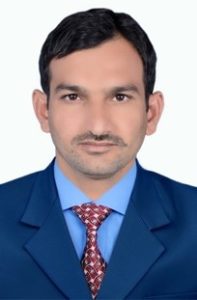 Dr. Muhammad Munir Sajid is currently working as a postdoc employee at School of Physics at Henan Normal University. He has obtained his PhD in Physics from Government College University (GCU), Faisalabad-Pakistan. His research interests includes; synthesis of composite nanoparticles & thin films synthesis via chemical methods for multifaceted applications i.e. Photocatalysis, bio-sensing, antimicrobial functions, and hydrogen storage applications.
Dr. Muhammad Munir Sajid is currently working as a postdoc employee at School of Physics at Henan Normal University. He has obtained his PhD in Physics from Government College University (GCU), Faisalabad-Pakistan. His research interests includes; synthesis of composite nanoparticles & thin films synthesis via chemical methods for multifaceted applications i.e. Photocatalysis, bio-sensing, antimicrobial functions, and hydrogen storage applications.
 Dr. Haifa Zhai is currently an associate professor in the School of Materials Science and Engineering at Henan Normal University, China. He received his PhD degree in Materials Physics and Chemistry at Nanjing University (NJU) in 2011, China and worked as a postdoctoral researcher in NJU from 2011 to 2013 and visiting scholar in Chemical Engineering at the Sungkyunkwan University (SKKU) from 2018 to 2019. His current research interests focus on sustainable energy and environmental science based on nanostructured functional materials.
Dr. Haifa Zhai is currently an associate professor in the School of Materials Science and Engineering at Henan Normal University, China. He received his PhD degree in Materials Physics and Chemistry at Nanjing University (NJU) in 2011, China and worked as a postdoctoral researcher in NJU from 2011 to 2013 and visiting scholar in Chemical Engineering at the Sungkyunkwan University (SKKU) from 2018 to 2019. His current research interests focus on sustainable energy and environmental science based on nanostructured functional materials.
Dr. Naveed Akhter Shad is currently working as PSA (Senior Researcher) at National Institute for Biotechnology and Genetic Engineering (NIBGE), Faisalabad-Pakistan. He has obtained his PhD in Physics from Government College University (GCU), Faisalabad-Pakistan. His research interests includes; synthesis of novel nanomaterials for multifarious applications i.e. Photocatalysis, Photo electrochemical, Electrochemical bio-sensing, HRP, super capacitors and Hydrogen storage features.
 Dr. Muhammad Shafique completed his doctorate degree in Department of Medical Microbiology, University Medical Center Groningen (UMCG), Groningen, The Netherlands in 2013. After completing PhD, I am working as Assistant Professor in Department of Microbiology, Government College University Faisalabad, Pakistan. His research is focused on viral/bacterial diseases of humans like HCV, HBV, RSV & Measles as well as animals such as NDV and IBDV. The group is also working for development and evaluation of animal vaccines (poultry) by using novel techniques against Newcastle Disease virus.
Dr. Muhammad Shafique completed his doctorate degree in Department of Medical Microbiology, University Medical Center Groningen (UMCG), Groningen, The Netherlands in 2013. After completing PhD, I am working as Assistant Professor in Department of Microbiology, Government College University Faisalabad, Pakistan. His research is focused on viral/bacterial diseases of humans like HCV, HBV, RSV & Measles as well as animals such as NDV and IBDV. The group is also working for development and evaluation of animal vaccines (poultry) by using novel techniques against Newcastle Disease virus.
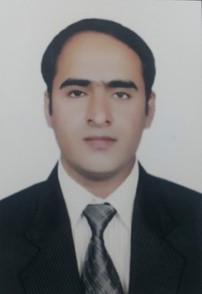 Dr. Amir Muhammad Afzal is currently working as an Assistant Professor at Riphah International University, Lahore. He has obtained his PhD degree in Physics from Sejong University, Seoul, South Korea. Besides, he has also completed Postdoc from Kwangwoon University, Seoul, South Korea. His research interests includes TMDs based Nano devices such as FETs, photodetectors, Solar cells and sensors.
Dr. Amir Muhammad Afzal is currently working as an Assistant Professor at Riphah International University, Lahore. He has obtained his PhD degree in Physics from Sejong University, Seoul, South Korea. Besides, he has also completed Postdoc from Kwangwoon University, Seoul, South Korea. His research interests includes TMDs based Nano devices such as FETs, photodetectors, Solar cells and sensors.
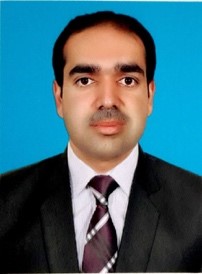 Dr. Yasir Javed did his PhD at Universite denis diderot-Paris 7, France. He is currently working as assistant professor in University of Agriculture Faisalabad, Pakistan. His research interests are synthesis of metal oxide nanomaterials for biomedical, sensing and photocatalysis applications.
Dr. Yasir Javed did his PhD at Universite denis diderot-Paris 7, France. He is currently working as assistant professor in University of Agriculture Faisalabad, Pakistan. His research interests are synthesis of metal oxide nanomaterials for biomedical, sensing and photocatalysis applications.
 Dr. Sadaf Bashir Khan is currently working as a postdoc researcher in Institute for Advanced Studies (IAS), China. She received her Ph.D. degree in Material Science and Engineering from Tsinghua University, Beijing, China. She has expertise in thin films fabrication and nanaparticles sysnthesis via PVd techniques and chemical methods. She did simulation and modeling of a single layer, bilayer, and multilayer or composite coatings and synthesizing nanoparticles according to photocatalytic and optoelectronic applications for solar cell applications and eliminating environmental pollution.
Dr. Sadaf Bashir Khan is currently working as a postdoc researcher in Institute for Advanced Studies (IAS), China. She received her Ph.D. degree in Material Science and Engineering from Tsinghua University, Beijing, China. She has expertise in thin films fabrication and nanaparticles sysnthesis via PVd techniques and chemical methods. She did simulation and modeling of a single layer, bilayer, and multilayer or composite coatings and synthesizing nanoparticles according to photocatalytic and optoelectronic applications for solar cell applications and eliminating environmental pollution.
 Prof. Nasir Amin is currently working as a Professor of Physics at Government College University Faisalabad-Pakistan. He had worked as Acting Vice Chancellor, Dean Faculty of Physical Sciences, Chairman Department of Physics and chaired various key administrative positions at Government College University Faisalabad. He had established state of the art laser spectroscopy lab at UAF and modern Nanomaterials Bio-sensing research centre & PLD lab at Government College University Faisalabad-Pakistan.
Prof. Nasir Amin is currently working as a Professor of Physics at Government College University Faisalabad-Pakistan. He had worked as Acting Vice Chancellor, Dean Faculty of Physical Sciences, Chairman Department of Physics and chaired various key administrative positions at Government College University Faisalabad. He had established state of the art laser spectroscopy lab at UAF and modern Nanomaterials Bio-sensing research centre & PLD lab at Government College University Faisalabad-Pakistan.
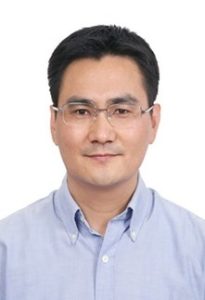 Prof. Zhengjun Zhang received his B.S., MS and Ph.D degrees in Materials Science and Engineering from Tsinghua University in 1991, 1993, and 1995, respectively. He is currently a Professor at School of Materials Science and Engineering in Tsinghua University. His major research interests are nanostructures and thin films fabrication and characterization, plasmonic nanostructures, chemical and biological sensors, nano-photocatalysts.
Prof. Zhengjun Zhang received his B.S., MS and Ph.D degrees in Materials Science and Engineering from Tsinghua University in 1991, 1993, and 1995, respectively. He is currently a Professor at School of Materials Science and Engineering in Tsinghua University. His major research interests are nanostructures and thin films fabrication and characterization, plasmonic nanostructures, chemical and biological sensors, nano-photocatalysts.
Could you briefly explain the focus of your article to the non-specialist (in one or two sentences only) and why it is of current interest?
The focus of the present study is to:
- Construct 1T-MoS2@(Bi1-xFex) VO4 heterostructures through the sonication-assisted hydrothermal method and analyze its visible light-dependent photocatalytic activity.
- Besides this, the mechanism involved for the synthesis of heterostructures and optimum condition for photocatalytic degradation of crystal violet (CV) dye is explored and discussed thoroughly.
How big an impact could your results potentially have?
Semiconductor photocatalysts compounds have an array of emergent properties of interest to the materials science community. The outcomes of this study will contribute to synthesize stable, resistant and reusable catalyst to handle the industrial organic pollutant degradation in an economical, cost-effective and easy way. However; it would take some time to get mature for industrial applications.
Could you explain the motivation behind this study?
This study is part of a larger effort to understand and control the surface area and electron-hole pairs separation to enhance the photocatalytic activity, From the literature survey, Bismuth vanadate (BiVO4) and Ferric Vanadate (FeVO4) are potential candidates for light-driven photocatalysts due to narrowband gaps ranging from 2.0 to 2.72 eV due to their remarkable chemical stability, noble catalytic activity, minimal optical damage and commercial cost-effective availability Both BiVO4 and FeVO4 possess a suitable energy band in a visible light range indicating tremendous photocatalytic and electrochemical applications. It is also observed that in scheelite ABO4 the B site was partially filled by substituted material. Taking the same idea in the monoclinic BiVO4, Bi3+ is 8 coordinated with ionic radius 1.17 Å, and the ionic radius of 4-coordinated V5+ is 0.355 Å. FeVO4 has two different crystal structures including triclinic (P-1) and orthorhombic (cm) symmetry respectively. The ionic radius of 8-coordinated Fe3+ is 0.78 Å. Reviewed literature has suggested that the heterostructures of BiVO4-FeVO4 would be useful in generating efficiency of electron-hole pair and thus enhancing the photocatalytic activity of (Bi1-xFex) VO4 heterostructures nano photocatalyst. Meanwhile, from a literature study, MoS2 is very sensitive for photodetection, moreover large electronic conductivity, substitute for noble metals co-catalysts, the abundance of existence, cost-effectiveness. MoS2 in cooperation with (Bi1-xFex)VO4 and enhanced the light absorption intensity range in the visible region of light. The small MoS2 co-catalysts particles close intact with (Bi1-xFex)VO4 and generate a nanoporous structure that offering more active agent sites.
Inspired by these concepts, 1T-MoS2 quantum dots-interspersed in (Bi1-xFex)VO4 hereafter 1T-MoS2@(Bi1-xFex)VO4 heterostructures were prepared through sonication assisted hydrothermal method. The synthesized 1T-MoS2@(Bi1-xFex)VO4 heterostructures exhibit excellent visible light-dependent photocatalytic activity. Photoluminance study revealed excellent controlled electron-hole transfer activity. The 1T-MoS2@(Bi0.40Fe0.60)VO4 heterostructures with 2.0 wt% of 1T-MoS2 loading with mix phase exhibited optimal enhanced photocatalytic response, as well as good stability and reusability.
In your opinion, what are the key design considerations for your study?
The key design considerations were elaborated in the schematic figure below:
- Key design considerations of 1T-MoS2 quantum dots-interspersed (Bi1-xFex)VO4 heterostructures
- Increment in the electron-hole separation mechanism
- To enhance catalyst surface area
- Control electron transport
- Heightened photocatalytic properties
Which part of the work towards this paper proved to be most challenging?
Optimum conditions prerequisite for the construction of 1T-MoS2@(Bi1-xFex) VO4 by the dosage variation effect of 1T-MoS2 on the photocatalytic activity of the photocatalysts were the most challenging task.
What aspect of your work are you most excited about at the moment?
We feel excited at two moments firstly, when we synthesize 1T-MoS2@(Bi1-xFex) VO4 heterostructures appropriately and secondly when we practically and experimentally improve photocatalytic response which is ascribed due to the higher electron transfer from semiconductor to the MoS2 surface and as a result, hinders the fast electron-hole recombination.
What is the next step? What work is planned?
In the future, we are planning to extend the current design using biocompatible polymers to fabricate and synthesize multifunctional bendable polymer-based nanocomposites thin films for sensing or energy storage application besides degradation of environmental pollutants.
Construction of 1T-MoS2 quantum dots-interspersed (Bi1−xFex)VO4 heterostructures for electron transport and photocatalytic properties
Muhammad Munir Sajid, Haifa Zhai, Naveed Akhtar Shad, Muhammad Shafique, Amir Muhammad Afzal, Yasir Javed, Sadaf Bashir Khan, Nasir Amin and Zhengjun Zhang
RSC Adv., 2021,11, 13105-13118
DOI: 10.1039/D1RA00807B, Paper
 Submit to RSC Advances today! Check out our author guidelines for information on our article types or find out more about the advantages of publishing in a Royal Society of Chemistry journal.
Submit to RSC Advances today! Check out our author guidelines for information on our article types or find out more about the advantages of publishing in a Royal Society of Chemistry journal.
Keep up to date with our latest HOT articles, Reviews, Collections & more by following us on Twitter. You can also keep informed by signing up to our E-Alerts.



